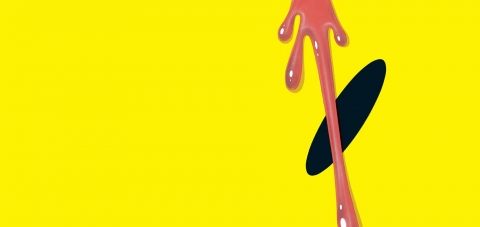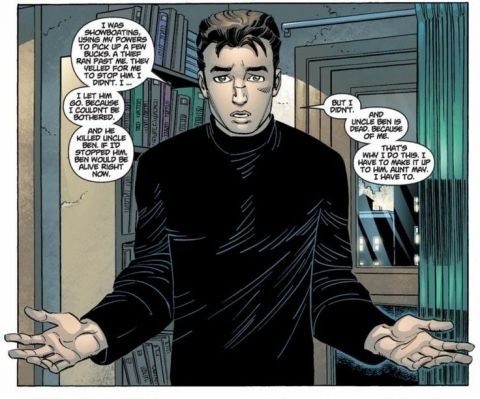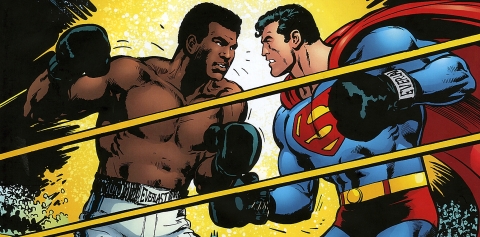52 weeks. 52 different writers. 2 trade paperbacks or hardcovers a week. Each week I’ll take a look at a different writer and read two different collected editions from within that person’s repertoire to help in the examination of their work. This week we take a look at some of the New 52 work done by the space maestro himself, Keith Giffen.
Keith Giffen
Keith Giffen has proven himself to be a fantastic space/sci-fi writer when it comes to comics. He’s most likely well known for his phenomenal and undervalued Marvel event, “Annihilation”, an event that essentially resurrected the entire cosmic Marvel line and launched it into the spotlight while Civil War was occurring. But today we aren’t here to talk about his Marvel work. Instead we’re looking at his DC comics work, with Giffen having written plenty of Justice League comics for the publisher. Giffen collaborated with frequent co-writer J.M. DeMatteis to bring the world five years worth of Justice League stories back in the day and the two have even won an Eisner award together for their mini-series “Formerly Know As The Justice League”. The two men got back together again to bring their off brand sense of humour and odd story telling to the Justice League one more time for the New 52 by giving the world Justice League 3000.
Justice League 3000 Volume 1: Yesterday Lives
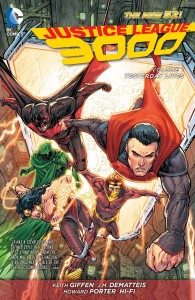 Justice League 3000 is written by Keith Giffen and his long time collaborator J.M. DeMatteis and features the Justice League thrust into the 31st century with no true recollection of their past. The Justice League become the weapon of choice for the highly advanced group Cadmus, as Cadmus tries to use the League to defeat The Five, a group of five evil people who have been conquering galaxies for many years.
Justice League 3000 is written by Keith Giffen and his long time collaborator J.M. DeMatteis and features the Justice League thrust into the 31st century with no true recollection of their past. The Justice League become the weapon of choice for the highly advanced group Cadmus, as Cadmus tries to use the League to defeat The Five, a group of five evil people who have been conquering galaxies for many years.
In co-writing this volume Keith Giffen splits the major story duties right down the middle with J.M. DeMatteis, as Keith handles the plotting while DeMatteis is placed in charge of the dialogue. As such I can only fairly examine the plotting of the stories and how the characters develop as the story unfolds.
There are more than a few futuristic settings throughout the story, whether you’re shown the mobile science planet of Cadmus or the rundown Takron-Galtos. Each setting has an appearance that is easily distinguishable from the next and it’s through the story that you actually get a great sense of how the characters interact with these environments. What’s great about a few of these settings, beyond the fact that they help to elevate the quality of the story, is the role they play for certain story beats as well. Giffen shows he understands these environments and how they function, showing us through the story the rules he’s set in place for them. Furthermore, the secrets behind some of these settings help to propel the story forward, like the truth behind Takron-Galtos.
In throwing the Justice League into the 31st century you get exactly what you’d expect, characters outside of their comfort zones and high sci-fi elements. There is plenty of high tech equipment on display throughout the story, introducing key items like transversal portals or the science behind how the League exists in the 31st century. The truth behind how the League are in the 31st century and the science behind it are things that actually make the story fascinating. When these truths are exposed it brings forth many major philosophical questions for the characters and even results in furthering their development.
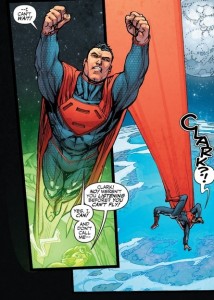
The story has a surprising rhythm to it, taking deliberate paces each issue that set you into a familiarity by the volume’s end. Giffen divides the story in such a way that you can predict when a scene will transition but that doesn’t take away from the overall experience. Instead, it serves to excite you as you can start to sense when you’ll go from a scene with a few members of the League to a scene with just the Green Lantern and what he’s experience or checking in with the Wonder Twins on Cadmus. In most instances, predictability would hinder your reading experience but with Justice League 3000 there’s something unique in the way the story is presented. It might simply be the simplicity and freedom from continuity that makes things feel different but nonetheless, even though you can predict the sequence of scenes easily, the scenes themselves still yield plenty of unexpected circumstances. In having a predictable rhythm but unpredictable story beats you get an odd sense of comfort as you move through the story. You know you’ll find out the Wonder Twins are up to something, but what exactly are they up to? You know Batman will be the one League member to keep it all together but what will he do to make sure he comes out on top? It’s questions like these that’ll keep you marching along through this story. The one true downside to this familiarity is the fact that when it is upset you’re temporarily taken out of the story. Giffen also takes you out of the story at times by having small things play out off panel. These things aren’t story breaking by any means but it’s definitely enough at times to make you wish you saw it happen instead of just having a character explain it to you.
Keith Giffen takes a fairly mundane idea that’s been done before, heroes being thrust centuries into the future, but spins it in a creative and rewarding way all because of the characters in this volume. Giffen swaps out the common personalities of all the heroes we know and love, inverting them in some instances to the point where, if not for visual aid, these characters would be unrecognizable. The personality swap has been done before in comics plenty of time but setting these old but still new characters into the future while they try to figure out why they’re so different from their past selves makes everything fun. Seeing a character like Superman, who is DC’s golden boy, act like an arrogant jerk the entire time is just an example of this. We’re given a Superman with a super ego as opposed to the humble counterpart we’ve all come to know and love. The character stays intact with similar powers and even his appearance but couldn’t be farther from the archetype personality that people know Superman for. There are still characters that stay rather close to their archetypes like Batman, Green Lantern and even Wonder Woman but Giffen goes the extra mile to blow up some of their average personality traits to extravagant size. Wonder Woman is still an Amazonian warrior but she has an almost over-the-top blood lust, always wanting to take the fight to someone instead of being tactical.
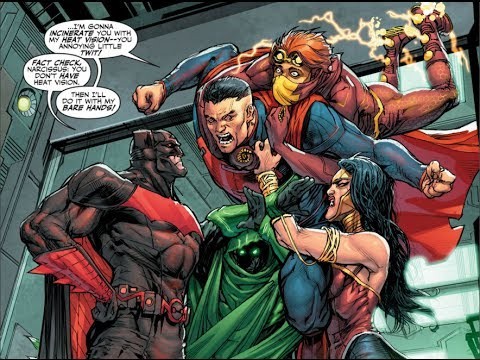
Collects: Justice League 3000 #1-7
Best Character: Superman
Best Line(s) Of Dialogue/Caption: “But you keep forgetting–that I can leap like a sonuvab*tch” – Superman
Best Scene/Moment: Locus vs. The League – Issue 2
Best Issue: Issue 4 – The Terrible Truth. It isn’t even a contest in trying to decide which issue is the best. Issue 4 stands out head and shoulders above every other issue in this collection because it informs everything that’s happening in the story. It explains why the characters are the way they are and builds the plot around that. You get a good blend of comedy with drama and to top it all off you get a well liked DC character making their surprising 31st century debut. The debut isn’t even half as rewarding as the truths unearthed in this issue though but that just speaks volumes as to how good the story gets because of it.
Why You Should Read It: The easy reason to read this volume is to see inverted personalities of your favourite heroes done well. To see Superman act like a total jerk wad is not only fun but hilarious. This collection of stories is Keith Giffen doing weird futuristic space stuff which he’s proven he’s got a knack for writing. The story has an odd style of momentum that kicks right up around issue 4 which is when all the larger puzzle pieces start to fall into place.
Threshold Volume 1: The Hunted
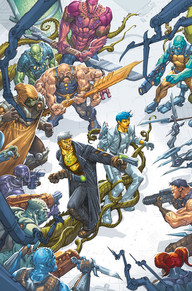 Remember how I mentioned above that Giffen was really good at this cosmic stuff? Well did you know that Keith Giffen is responsible for creating not only one cosmic character with fan cult status but two of them? Back in the mid-seventies, Giffen was the artist on issue Marvel Preview #7 in which he and Bill Mantlo brought the loveable Rocket Raccoon into the world. Then with the help of Roger Slifer during their Omega Men run, Giffen brought the alien mercenary Lobo into the world. Giffen is just a powerhouse at creating weird characters that everybody loves. Today’s book, Threshold , is no exception to that rule as it wouldn’t surprise me if one day we see any of the characters from this story gaining a cult following someday.
Remember how I mentioned above that Giffen was really good at this cosmic stuff? Well did you know that Keith Giffen is responsible for creating not only one cosmic character with fan cult status but two of them? Back in the mid-seventies, Giffen was the artist on issue Marvel Preview #7 in which he and Bill Mantlo brought the loveable Rocket Raccoon into the world. Then with the help of Roger Slifer during their Omega Men run, Giffen brought the alien mercenary Lobo into the world. Giffen is just a powerhouse at creating weird characters that everybody loves. Today’s book, Threshold , is no exception to that rule as it wouldn’t surprise me if one day we see any of the characters from this story gaining a cult following someday.
Threshold follows the exploits of Jediah Cull, a member of the Green Lantern Corp deep undercover who is trying to defeat Lady Styx. Jediah’s plan run awry when Star Sapphire, Arkillo and The BLue Dude show up seeking his help. Star Saphire is captured and sent to the planet Tolerance, a world where its citizens hunt valuable targets for financial wealth in a game show called “The Hunted”. When the attempt to save Star Sapphire from Tolerance goes south, it is Jediah Cull who ends up as an unexpected contestant on “The Hunted” without the help of a charged power ring.
If I’ve said it once, I’ve said it a million times: Keith Giffen is pretty darn good at this cosmic comic stuff. Threshold is perfectly in his wheelhouse as he takes an odd group of characters and sticks them into a corner with the odds stacked against them as there’s plenty of weird cosmic nonsense going on. Giffen handles dozens of different alien and human races throughout the entire volume, displaying a wide range of diversity. It isn’t like every single race that appears in this volume gets a chance at the spotlight but at the same time it isn’t always your prototypical white male leads all the way through either. You’ve got everything from an undercover Green Lantern to a cyborg rabbit mercenary to a space slug all in this story and that is genuinely only scratching the surface.
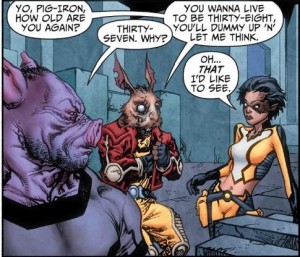
The primary protagonist of this story, Jediah Caul, falls into the rogue archetype. He’s a little bit brutish, out for himself but still has a heart of gold. He’s like a Han Solo-esque character only not nearly as charming and with a power ring stuck in his chest. As the story progresses you do see Jediah evolve and begin to realize why he was selected to be a Green Lantern in the first place, going full circle from scoundrel to hero. He is given a full character arc in a series of stories that feel cut short at every turn, so in that there is definitely a small victory.
As for the supporting cast, there are plenty of characters being lobbed around but none that really stick or catch you in an enticing manner. Captain K’Rot, a half robot half rabbit hybrid mercenary, is easily one of the most charming secondary characters in the volume, easily comparable to Rocket Raccoon wherein he’s a bit of a dick but still makes you laugh. The other dozen or so characters that you follow on Tolerance just seem to tread water as opposed to actually pushing their stories forward. That’s not to say there aren’t some promising narrative threads sown in because there definitely are, it’s just that most of them get shortchanged in favour of making sure Jediah’s story gets wrapped up before the end of the volume. You’ve got things like Blue Beetle teaming up with a New God or a girl who is repeatedly cloned when she dies falling into favour with a popular contestant named Stealth.
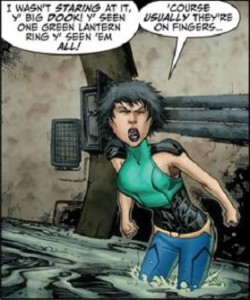
Overall the story lacks quite a few things like well developed story beats or a clear antagonist. The story starts out with it seeming like Lady Styx is the true enemy only to change gears and make it all about surviving on Tolerance. The need for survival does outweigh the need for revenge and also pushes the need for freedom. Then halfway through the volume Brainiac makes a random appearance and is seemingly cast in the lead antagonist role only to be shoved away rather promptly. It’s things like the lack of a clear villain that just hurt the overall story and stop you from falling truly in love with the oddball characters and environments introduced.
Speaking of these environments, the planet of Tolerance stands as the only primary setting for this story with many of the smaller locales on Tolerance serving as backdrops. Tolerance feels incredibly reminiscent of just about any futuristic planet you’ve seen or read about when it comes to a Sci-Fi story and not many of these locales stand out. The one location that does set itself out in front of the rest of them is the tower in which Bleeding Adonis, a ratings hungry space slug, resides in. It’s what I’d consider the hub of the latter half of the story with plenty of plot beats resting on its very pillars.
The unfortunate truth about this story as a whole is it just doesn’t have enough time to tell it all. Issue 8 is when this comic actually got cancelled and as such, Keith Giffen rushes to wrap everything up during that issue. Ironically enough, that issue might have been the best of the bunch as Giffen just throws caution to the wind and pokes fun at everything wrong with the comic industry. But more to the point, the story just doesn’t ever seem to make up its mind as to whether or not it was trying to be survival action, a mystery, or a comedic space romp. The book tries to be all three at times, with it paying off in some instances and just feeling odd at others. One can’t help but wonder if this was Giffen’s intent the entire time as he most certainly has a wacky mind for this sort of story telling style.
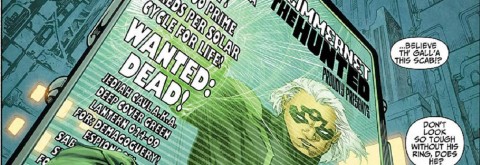
Collects: Threshold #1-8, Green Lantern: New Guardians Annual #1, Larfleeze back up stories #1-5
Best Character: Captain K’Rot
Best Line Of Dialogue/Caption: “I’ve known Caul since he first showed up on Tolerance. Ring or no, that one’s so full a’ himself, ain’t no room for no one else. I admire that in a sentient.” – Captain K’Rot
Best Moment/Scene: Jediah Caul in an office brawl – Issue 8
Best Issue: Issue 8. What makes this issue so great isn’t the fact that it concludes the story but it’s the way the story is concluded. It’s one of those things that it’s easier to describe after its been read. To put it bluntly, issue 8 wraps everything left hanging up in a hurry as it is the issue in which this comic gets cancelled. As such, throughout the entire comic there’s a ton of tongue in cheek references to the fact that the book is gettting cancelled, with plenty of classic Keith Giffen humour to go with it. You watch as all the characters react to the confusing turn of events and you get an ending that will have you laughing over its simple brilliance and its satirical take on the comic industry as a whole.
Why You Should Read It: Giffen has a dark sense of humour and wit that is hard to find among most comic veterans. Anything cosmic related with Giffen’s name on it is typically a must read for fans of weird stuff. He has a knack for writing oddball characters that people fall in love with. But to circle back to that wit I mentioned, Giffen isn’t afraid to say things about the comic industry that might upset publishers and there isn’t a finer example of that than issue 8 in this collection. The story might not be the strongest here but issue 8 alone is a book that warrants “purchase on sight” status.

